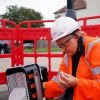Openreach Expected to Ramp Up UK Full Fibre Broadband Rollout
The new CEO of BT Group, Philip Jansen, is reportedly preparing to announce a major ramping up of Openreach’s 1Gbps capable Fibre-to-the-Premises (FTTP) ultrafast broadband ISP technology next week, which one analyst firm believes could see them target 15 million premises by around 2025 instead of 10 million.
At present Openreach’s existing “Fibre First” strategy aims to build “full fibre” broadband out to cover 3 million homes and businesses by the end of 2020 (i.e. March 2021 financial) and they also have an ambition to reach 10 million by around 2025, although the latter remains dependent upon a satisfactory result from their negotiations with Ofcom, ISPs and the Government. So far 1.2 million premises have already been covered (here).
We have long predicted that one of Jansen’s first acts after taking over as CEO would be to confirm their strategy for a “large scale” roll-out of FTTP (i.e. the 10 million premises target), which the operator has previously estimated could cost between £3bn to £6bn. But the rising levels of competition from new alternative network ISPs (Summary of Full Fibre Plans) may be putting pressure on them to go even further.
Advertisement
According to the FT (paywall), sources with direct knowledge of the proposals say that a new plan has now been presented to Openreach’s board and we’re likely to hear more about this when BT publishes their next results. Research company Redburn has predicted that their 2020 target could be boosted to 3.5 million premises, while their 2025 ambition may jump to 15 million premises.
All of this is dependent upon the operator being able to secure the necessary changes in regulation and other areas, as well as Jansen’s rumoured plan for 25,000 job cuts (here). Back in 2017 the network giant found “broad support” for their proposal to conduct a “large scale” roll-out of FTTP among ISPs and they also identified a list of key enablers for this (here). Some of these are already being tackled.
Openreach’s List of Enablers for Larger Scale FTTP
· Greater collaboration, including new investment, risk and cost sharing models.
· Agreement on how mass migration of customers onto the new platform can be achieved (Openreach proposed that all customers should be migrated over to the new network as quickly as possible – and retiring the old copper one – after it has been built in a given area).
· Reducing logistical barriers, like improved planning and traffic management processes.
· Agreement on the right way to spread the costs of FTTP investment (e.g. possible changes to business rates and wholesale rules / charges).
· A legal and regulatory environment which encourages investment.
Since then the ramping up of FTTP deployments by rivals has weakened Openreach’s bargaining position, which means that choosing not to do a larger roll-out now would risk eroding their place within the market. One key challenge for Openreach is that, unlike their rivals, they face a mountain of historic regulation and a lot of that needs to be rebuilt for the full fibre age (Ofcom are in the process of doing this).
Meanwhile altnet ISPs are concerned that a more aggressive push by Openreach into FTTP could disrupted their own projects, reduce coverage improvements through overbuild, create more disruption for locals (i.e. repetitive street works by different operators in the same area) and enable the telecoms giant to slowly rebuild its position.
Advertisement
On the flip side the majority of this battle is taking place in commercially competitive urban areas (i.e. doesn’t generally involve any public investment) and that is seen by many as fair game for whoever (private sector) wants to take the risk by spending big on it. Similarly overbuild also increases consumer choice, which is a positive.
All of this will no doubt help the Government to achieve their current target of supporting FTTP networks to cover 10 million UK premises by the end of 2022, then 15 million by the end of 2025 (here) and they also have an ambition to see a “nationwide full-fibre” network by 2033. This will of course involve input from many alternative network ISPs and not just Openreach.
Interestingly Openreach’s recent consultation on their proposals to switch-off the old copper network (here) also hinted at one casualty of a wider than currently proposed FTTP deployment. This reflects the possibility of another reduction in their roll-out of 330Mbps capable hybrid fibre G.fast technology.
Until recently G.fast was due to reach 10 million UK premises by 2020 and then the greater focus upon FTTP caused that to be downgraded to around 5.7 million (here). The copper switch-off consultation hinted that they might instead need to take an even more targeted approach to G.fast (i.e. only using it in specific areas as part of the FTTP roll-out), which could be interpreted to mean another downgrade. We’ll find out soon enough.
Advertisement
Mark is a professional technology writer, IT consultant and computer engineer from Dorset (England), he also founded ISPreview in 1999 and enjoys analysing the latest telecoms and broadband developments. Find me on X (Twitter), Mastodon, Facebook, BlueSky, Threads.net and Linkedin.
« Moans After £22.7K Openreach FTTP Quote for 5 Rural Fife Homes


















































Comments are closed